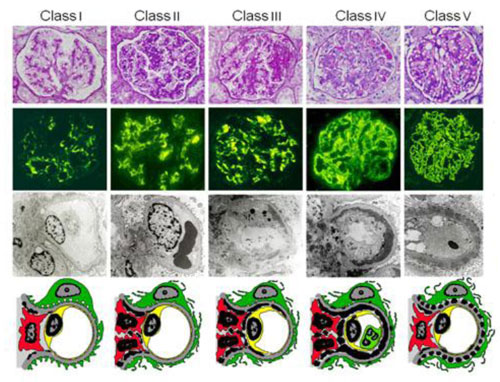Lupus nephritis is suspected and may be diagnosed when blood or protein is found in the urine. Another diagnosis test that can indicate a problem is when the serum creatinine level in your blood is abnormally high. This can result in a decreased Glomerular Filtration Rate (GFR). Doctors estimate how well your kidneys are functioning using this test. Your doctor then might refer you to a nephrologist for a kidney biopsy. A biopsy is the only test which can diagnose lupus nephritis.
Once you have a biopsy, the sample is then identified based upon the degree and pattern of swelling and damage. This is shown in the table below. There are six classes of the disease and your diagnosis should indicate which class you have. The severity of your disease is used by your kidney doctor or rheumatologist to make decisions with you about treatment options.
Table 1: The 2003 International Society of Nephrology and International Pathology Society Classification of lupus nephritis
- Class I: Minimal mesangial lupus glomerulonephritis (LGN)
- Class II: Mesangial proliferative LGN
- Class III: Focal LGN (< 50% glomeruli)
- Class IV: Diffuse LGN (> 50% glomeruli)
- Class IV-S: Predominantly segmental
- Class IV-G: Predominantly global
- Class V: Membranous LGN
- Class VI: Advanced sclerotic LGN (> 90% sclerotic glomeruli)

Why are these lupus classifications important?
There are several treatment choices for people with lupus nephritis. Some of these treatment options are considered “aggressive.” They also have side effects which may not be appropriate for individuals with certain forms of lupus nephritis. The classes were based on several factors that help doctors discuss the best treatment options and outlook for people with lupus nephritis.
- Class I: Mild disease with small amount of swelling
- Class II: Still fairly mild disease but more swelling than Class I
- Class III : Moderate degree of swelling with less than 50% of the filtering units (glomeruli) affected
- Class IV : Severe degree of swelling with greater than 50% filtering units affected
- Class IV-S: Of the affected filtering unit, less than ½ of it is affected by swelling
- Class IV-G: Of the affected filtering unit, most of it is affected by inflammation
- Class V: Most of the swelling is confined to the outer layer surrounding the filter unit
- Class VI : Most of the filter units show scarring